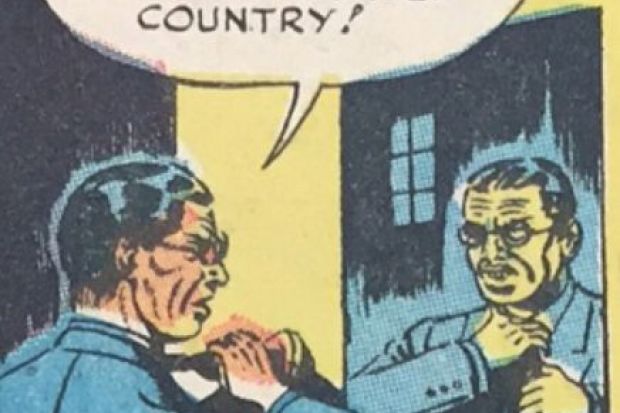How far have our assumptions and stereotypes about professors been shaped by comics?
Pauline Reynolds, associate professor in education at the University of Redlands, has long studied the “representation of higher education” in popular culture such as “the movies of the 1930s and 1940s and TV shows like Greek”.
The many comic book characters found in films led her to turn her attention to comic books themselves.
These formed the subject of a paper that she wrote with her research associate Sara Durazo-DeMoss (California State University) and delivered at the annual conference of the Society for Research into Higher Education, which was held in Wales earlier this month.
Their analysis examined “the portrayal of academics as main or support characters in over 100 comic books from Superman (1938) to Squirrel Girl (2015)”.
The sample included a wide variety of different stories. Some, the paper explains, feature “young people [who] treat university as an inevitable next step after high school” and go on to appear, for example, in what one comic described as “pulsating tales of the care-free lives and intimate loves of enchanting co-eds” – invariably depicted in their underwear.
Yet the authors also flagged up the adventures of “superheroes go[ing] to college under the cover of their secret identities” and even heroic animals “saving the day in some way on campus, including Lassie and Yogi Bear”.
Yet despite this variety, certain themes keep recurring.
Although novels often revolve around professors of English, and the films of the 1930s and 1940s feature more psychologists than any other kind of academic, disciplines in the science, technology, engineering and mathematics fields are almost totally dominant in comic books. Part of the explanation, the authors suggested, is that the sciences lend themselves to the kinds of “observable and instantaneous action”, such as firing laser beams at distant planets, highly suited to the narrative style of comics.
Given that “masses of young people have consumed repeated messages about higher education from comic books since the 1930s”, the paper also examined some of the assumptions and absences.
For instance, the authors found only three female professors in their whole sample, and none fares particularly well.
One is mauled and killed by Dracula on the very first page of the comic in which she appears. Another is “bullied by students about her looks” and, unconscious after an accident, “given a physical transformation without her consent by Supergirl’s under-the-sea Atlantean friends”. A third is accidentally blinded after being taken “into space to witness an astronomical event for her research” and explodes into “an intense, sustained, exaggerated and irrational fury” revealed through “distorted facial features”.
Two of the three “men of colour” the authors discovered in their sample comics are also “harmed” in some way. All are also relatively light-skinned and foreigners in the US: a Japanese professor in the 1940s, a Latino professor in the 1970s and a Brazilian professor in the 1990s.
Completely absent are “Americans of colour portrayed as academics”. The Brazilian, moreover, is shown as “an untrustworthy figure” who reduces a student to tears, presenting a “stark contrast with the predominantly saintly if sometimes affectionately mishap-prone portrayals of white, male professors”.
Such comics, reflects Dr Reynolds, “over-exaggerate the dominance of white men. That can be quite dangerous and is perhaps part of why women and minorities get more pushback in real life.”




